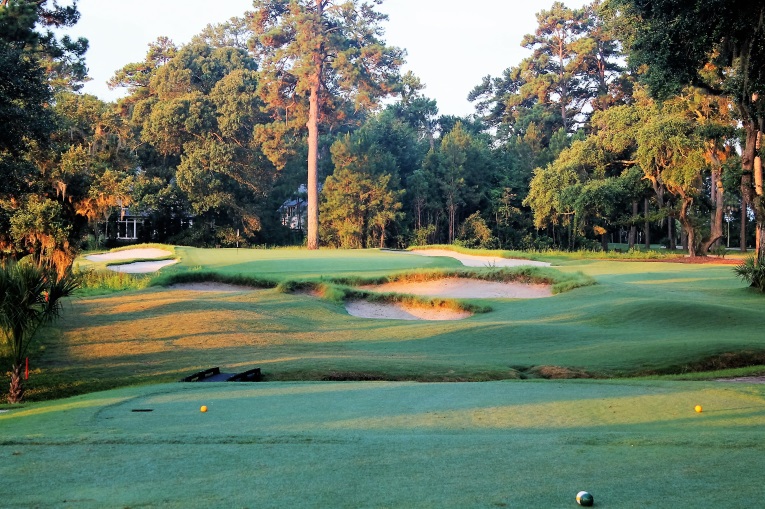Chechessee Creek Club
South Carolina, USA
Chechessee Creek Club is a throwback to a time when golf was simpler.
Gone are the insipid mounds that plague so many modern coastal South Carolina courses. Gone are the long green to tee hikes that make riding a golf cart a foregone conclusion. Gone is sacrificing sound course design in the quest of a signature hole. Gone are decorative waste bunkers of no strategic value. Gone is the fear of losing golf ball after golf ball in man-made water hazards. Gone is the concept that a course built today must adhere to some banal formula of par 72, 7,000 plus yards.
What is apparent are traditional design elements of the kind that the coast of South Carolina has rarely seen since Seth Raynor worked in Charleston in the 1920s. Just as the sub-7000 yard Harbour Town with its small greens was revolutionary in the early 1970s, Chechessee’s sub-6,700 yard design is a welcome return to shotmaking. That was true when it opened in 2000 and in some ways, the merits of the course are even more apparent in 2016 (when this profile was updated). More on that later.
At the time of its construction in 1999, every architect was building long and longer but Bill Coore didn’t think that approach made sense for this property. Instead of big and rambling, he felt the design ‘…needed to be intimate, wrapping around and through the trees.’ To that end and to best reflect the charms of the Lowcountry, restraint was called for, starting with the tees which are simple, squared affairs and never built more than a yard or two above their surrounds. The golfer is reminded of Garden City (where Ben Crenshaw is an Honorary Member) and the uncluttered simplicity of those tees. There are no steps for the golfer to walk up and the countless tee areas that Ron Whitten complained of in his Feature Interview are mercifully absent.
Next, out in the fairway, the course enjoys the same low profile features of a Yeamans Hall or Pinehurst No.2. The absence of artificial mounding harkens to the Golden Age of course design when dirt wasn’t mindlessly pushed around to ‘frame’ holes. In terms of dirt the coastal islands are a mix of clay and sand, so, fill was brought in to raise each fairway two to four feet and each fairway was capped with six inches of sand for drainage and to insure running, bouncy conditions. Ironically, Chechessee Creek with its ground-hugging features ranks near the top of Coore & Crenshaw’s projects in terms of the volume of earth moved. Yet, literally no one guesses that, so peacefully do the fairways fall across the land and bleed into their surrounds on the edges.
The only other dirt of consequence that was disturbed was to create the pushed-up green complexes. Jim Craig was the sole C & C dozer man on the job and he roughed in all the greens (save for the thirteenth), some of the fairways and did all of the finishing dozer work. Coore said of their plan ‘move as much dirt as you need to for drainage, then we will highlight some areas’. As Dave Axland notes, ‘I think the same is true for the golf, Bill and Ben did what was necessary for fun golf and no more.’ More architects need to adopt the same sensible, minimalist approach.
The pushed-up green pads sometimes start as extensions of the fairway and never rise more than three yards above their surrounds. Similar to their Kapalua Plantation design, the greens vary widely in size, from the sub-4000 square foot first to the behemoth 10,365 square foot green found at sixteen. Many feature a false front of some degree and none are the multi-tiered affairs that invariably seem disjointed from their surrounds. Several (e.g. the third, fourteenth, and fifteenth) are bunkerless.
The variety of green sizes and their configurations are one of the design’s biggest assets. Other architects routinely build eighteen greens within 10% +/- of each other in size. The question is why?? Golf at the highest level is supposed to be about variety, yet most architects squander the opportunity. Look at the first green below:
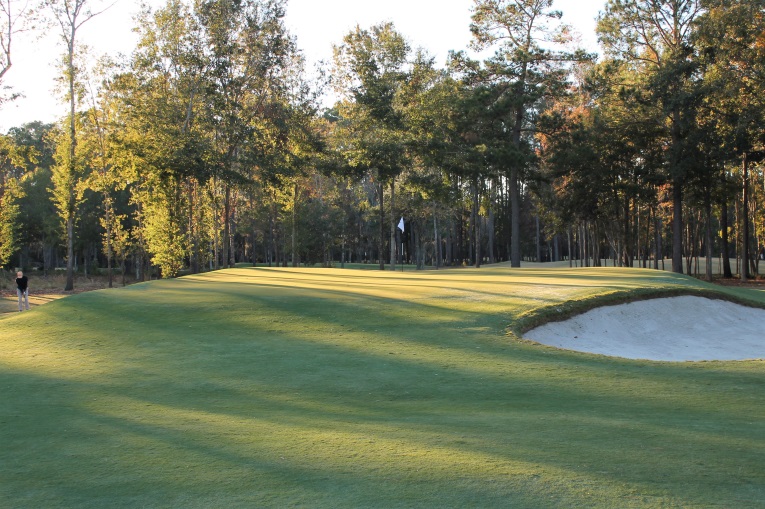
The 1st green complex is fraught with challenge with its tiny putting surface and fall-offs on all sides.
It represents a bedeviling start to the round and best yet, the golfer won’t face that exact sort of challenge again. Instead, he has to negotiate a false front at the second, the third green is an extension of the fairway, the angled fourth green is a scant 14 paces across, etc. The challenge continually varies, which puts the onus on the golfer to make correct decisions. On the second nine, the built-up fourteenth green pad is quickly followed by the bunkerless fifteenth green glued to the ground at grade. These alternating challenges don’t necessarily reveal themselves to the golfer after one or two rounds but rather, understanding and pleasure is gleaned over time.
When asked to explain the nuanced course and why he joined, Craig Disher put it this way: ‘Today’s course is incredibly picturesque, especially after the tree removal that exposed previously hidden gigantic live oaks. Just walking around the land is a pleasure. Importantly, it is as easy a walk as any modern course I’ve seen; I know I can finish my golfing days playing there without a cart. As for how it plays, there are tilts in the fairways – mostly subtle and must be learned by repeat play – which can be used to advantage. The shelves, mounds, and troughs that complicate the front surrounds make for an entertaining ground game. In my view, for a course to be rewarding to play on a regular basis, that is the single most important feature it should possess. Green Keeper Bill Kennedy’s maintenance practices – such as extending the close-cut surrounds far from the putting surface – create links-like conditions and multiple playing options across the invariably fast and firm playing surfaces through the green. In sum, I think CCC is such a pleasure because it embraces the same attributes that have long stoked my enjoyment of links golf.’
Such optimal conditions don’t occur by accident. Dave Proctor, who bought Chechessee Creek in 2012, has enabled aggressive topdressing of the fairways and surrounds in perpetuity. Kennedy will oversee the spreading of 1000 tons (50 +/- dump truck loads) of sand over short cut areas on an annual basis. Factor in other below surface work like the 8,000 linear feet of drainage that was added in 2015 and you start to get a more complete picture as to how Chechesse both looks and plays great as opposed to just looking the part.
As with all Coore & Crenshaw courses, the bunkering is noteworthy. The scruffy bunkers courtesy of Jeff Bradley amplify the low key, rustic appeal of the place. Like the greens, they vary wildly in size: the 100 yard long narrow trench bunker up the third fairway, cross bunkers at the eighth, a small pit that claws into the middle of the twelfth green, the massive bunker that guards the best angle into the fifteenth green. However, there are only 82 bunkers in total and similar to Royal Melbourne, rarely is any green bunkered on both sides. Similar to Pinehurst No.2 where Coore & Crenshaw worked, Coore considers Chechessee Creek to be an approach shot golf course. He half-way jokes to friends suggesting they always hit once less club into each green. He contends you will score just fine if your approach always finishes just on or just short of the green. As the more accomplished players chase back hole locations and miss greens left or right, the proceedings can get a bit messy. The golfer has to decide for himself where the best opportunity for an up and down lies: is it in the bunker or not? If not, should he try a running chip, flop or bounce it into the greenside bank?
Originally, the 360 acres were zoned for 130 home sites. After selecting the routing that maximized the site’s potential, it became apparent that accommodating that many homesites would have a detrimental effect on the golf as a continuous, uninterrupted experience. So, then owner Jim Chaffin decided to pare it down to 46 sites, insuring that golf forever comes first. Proctor has reduced the total by another 12% ensuring that the clean sight lines profiled here are forever preserved.
A by-product is that Coore & Crenshaw’s favorite mix of holes were allowed to stand. The course consists of five par threes and only three par fives. A lot of short holes coupled with a few long holes are never ideal for selling the most number of homesites. Since that was never the driving consideration, the golfer gets to play the best set of holes that Coore & Crenshaw could find on the property.
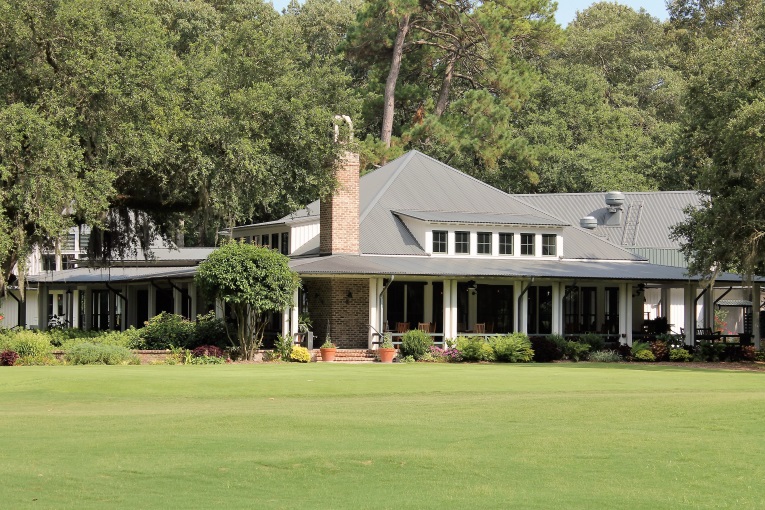
The Lowcountry ambiance that pervades at Chechessee Creek is further enhanced by the 9,200 square foot clubhouse, complete with its wrap around porch and ceiling fans.
After being open for fifteen years, the club took the unusual step in the summer of 2015 to re-grass the entire course. Proctor, who was a member when he bought Chechessee, was insistent on getting the playing surfaces to match the quality of the design and gave Green Keeper Bill Kennedy the resources to do so. TifEagle Bermudagrass replaced TifDwarf for the putting surfaces. Celebration Bermudagrass was selected for the other playing surfaces, save for the green surrounds where TifGrand Bermudagrass was employed. All told, 80 acres of turf were replaced. Celebration and TifGrand weren’t even available in 2000 when the course opened and more so than any other blade, Bermuda has made the most progress over the past fifteen years in producing surfaces conducive to good golf. Approach shots now enjoy more release and less grab. Most importantly, the art of chipping and recovery plays a vital role here and the turf quality around the greens is better now than it ever has been. The golfer draws lies on the TifGrand that allows him to play any sort of recovery shot while the old 419 Bermuda, patchy from shade sometimes robbed the golfer of intended options.
To aid the new Bermuda, Hilton Head based architect Clyde Johnson performed a sunlight study that impressed everyone. The resultant clearing of underbrush and unhealthy trees significantly improved the light and air flow, meaning the new Bermuda grasses are now set to thrive, something that Kennedy truly appreciates. Today’s course enjoys many more long interior views compared to its opening and more angel and live oaks are exposed. When asked if he wished they had cut down more trees initially, Coore responds, ‘No. You can’t cut them down and then stand them back up if you realize you have made a mistake. Our intent was always to leave them for a while and then revisit the situation periodically. The trees lend the land so much character that you have to move prudently. The trees and their presentation today at Chechessee Creek are something of which everyone should be very proud as it has been a very intelligent evolution.’
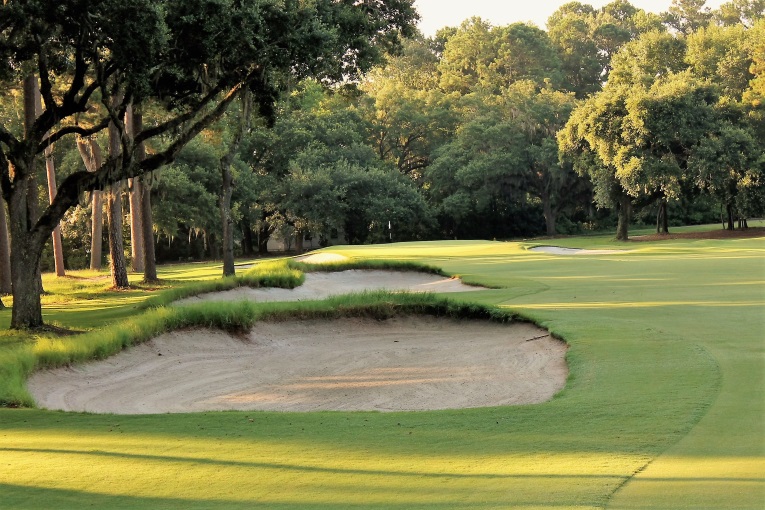
As part of the tree and sunlight study, great attention was paid to the greens and their surrounds. The tenth green, seen above, now soaks in morning light.
Kennedy has been there since the beginning and helped with the 1999/2000 grow-in. He is especially pleased how ‘… we have always endeavored to provide the best possible golf experience with as little impact to the environment as possible while preserving and strengthening the sense of place as a classic course in a Lowcountry rural setting.’ A recent visit from Naturalist and local TV celebrity, Tony Mills, confirmed that the work was paying off. Contrary to what one might assume, the more the club maintains the out of play areas, the more it acts as a wildlife habitat, and the club has witnessed a marked up turn in population of the Painted Bunting, Great Horn Owl, Red-headed Woodpecker, Great Blue Heron, deer and fox squirrel.
Lastly, a final tweak occurred in 2015 when Jeff Bradley returned and touched all 82 bunkers. For example, the front left one on the eleventh needed to be raised because it was below the water table. The most significant change occurred at the fifth where an 150 yard waste area that never drained properly was replaced with an attractive string of bunkers that serve the same purpose but function better.
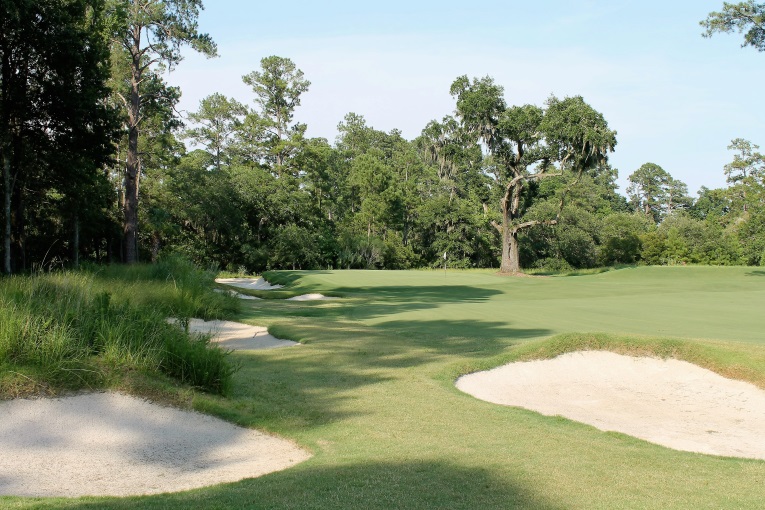
A series of bunkers replaced the original waste bunker and conclude with one that wraps around the back left of the green.
The course is the best that it has ever been, a statement that is simply not true for most sixteen year old courses that typically succumb to overdevelopment or sloppy practices or both.
Holes to Note
First hole, 370 yards; Coore loves this opener, in part as he notes, ‘It tells you what you are about to experience. You need to shape your tee ball or at least place it properly on one side of the fairway in order to enjoy the best approach. It clearly shows how this is a second shot golf course and that a finesse player who knows his limitations stands a real chance against a more powerful one who indiscriminately chases after every hole location.’ The first also epitomizes how much of the routing came to pass: it was all tree-based. As Coore says, ‘It is the only course we have ever built that was laid out completely around trees.’ In 1999, a survey was done for every tree on the property. Coore dotted the trees by diameter using a color code. When he was done, the four and five foot diameter trees stood out from the one foot diameter trees and the magnificent specimen oaks served as a guidepost for his routing. He categorically states that this is why the first hole is where it is and why it bends the way it does. Enormous live oaks are on the inside of the dogleg (the one seen below housed a den of foxes for a long while) and another large oak is front right of the green. Though the fairway swells to the right, the golfer surely wants to approach the platform green from the left.
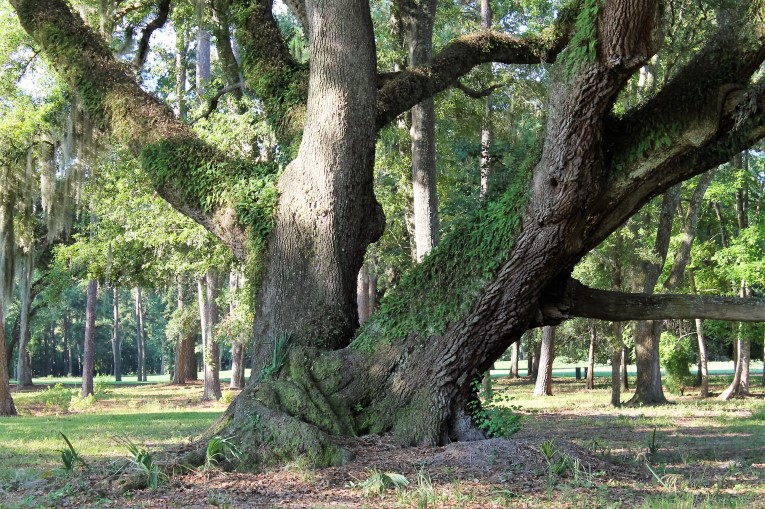
Some trees are more equal than others! This noble one down the left of the first fairway helps set the tone for the round ahead.
Third hole, 350 yards; Golden Age golf architect Tom Simpson’s stated desire was to make a course harder for the good golfer while providing room/enjoyment for the less accomplished. Countless modern architects have tried to reach that ideal but few succeed as well as Coore & Crenshaw do here. Franklin Newell, the long time Director of Golf, has studied play for sixteen years and observes, ‘The golf course lends itself to enjoyment for all caliber of players. We find that higher handicappers and ladies enjoy playing Chechessee Creek due to the lack of forced carries, hazards and out of bounds. They very rarely loose balls. At the same time, the course is a strong challenge to lower handicappers because the relatively small greens put great pressure on their approach shots.’ Case in point, the width of the third fairway is halved 275 yards from the tee. Most of us play to the wider section and are content with a 110 yard pitch to the green. Meanwhile, the tiger may elect to squeeze a fade farther down the fairway in hopes of a short pitch. Additionally, the less adventurous player can bumble his approach near the front of the open green with few worries while the better player needs to be mindful of the lateral hazard that tracks along the right side of the 30 yard deep green.

An approach hit for the middle of the green that is slightly pushed will likely be kicked right into the lateral water hazard …
Fourth hole, 410 yards; A classic misdirection play comes here, the only portion of the property where a large field had been cleared before the Boys went to work. On the tee, the golfer’s eye is captured by a sprawling bunker at the start of the fairway that hooks around the left. Happily, the golfer sees the flag toward the right, acting the siren. However, a string of four smaller bunkers down the right and a pair of right greenside bunkers define the ideal tee ball left-center. Standing behind the hole, the left to right angle of the green is obvious and substantiates that left center of the fairway is ideal. Many consider this the most clever hole on the course. As Axland said, ‘If I had to pick a favorite, or perhaps better put, a hole that was a bit different and yet complimentary to the others, it would be number four.’
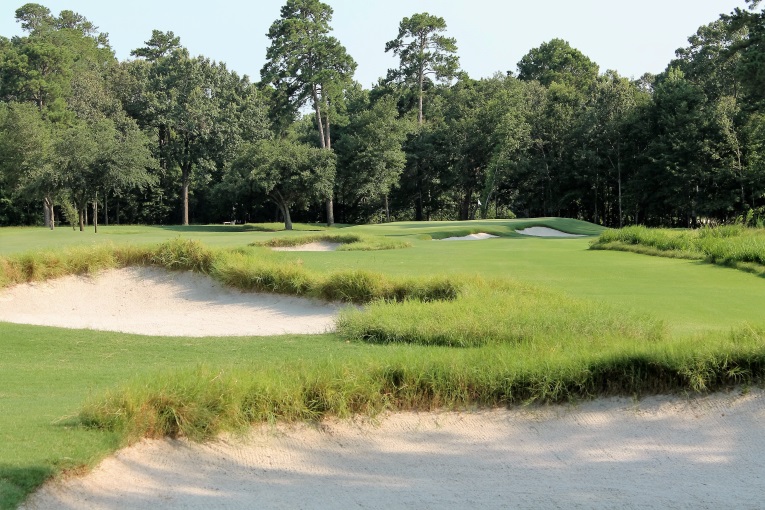
One can go an entire playing season and not see a golfer hit the green (which is canted from right to left) from the right rough or right bunkers.
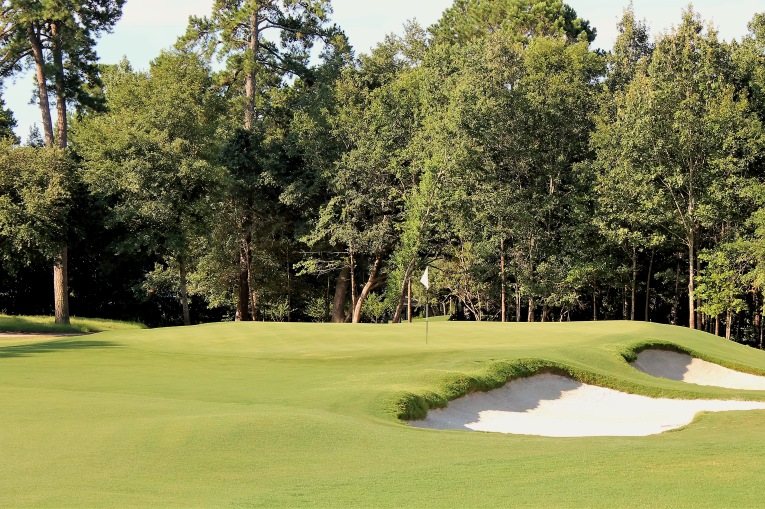
Barely visible from the tee, this pair of bunkers that protrude from the green dictate that the best angle of approach is indeed from the fairway’s left center. The uneven ground before the putting surface adds interesting wrinkles to the approach.
Sixth hole, 435 yards; The more things an architect can ask of a player, the better. Having said that, on a piece of property where the high-to-low point is a mere five feet, rambunctious topography is not an element at the architect’s disposal. To create interest off the tee, Coore & Crenshaw often bend the playing corridors one way or another. Often at those times, there are no bunkers in the hitting area such as here, the first, fifth, and eighteenth. On the straighter holes like the fourth and eighth, bunkering enters the equation to lend interest. Here, the player than can shape a draw off the tee gains an advantage.

Note the pleasure that the distant solitary walker with her trolley must be experiencing among the cathedral of pines with views of Chechessee Creek in the background. This photograph is taken from a new forward tee built in 2015. Newell explains its genesis: ‘Bill Coore visited Chechessee several months prior to our renovation in order to analyze possible changes or alterations. He noticed that the course played too long for the majority of our lady members and opted to add seven new forward tees, which also provided the opportunity for us to move our shortest men’s tees forward.’
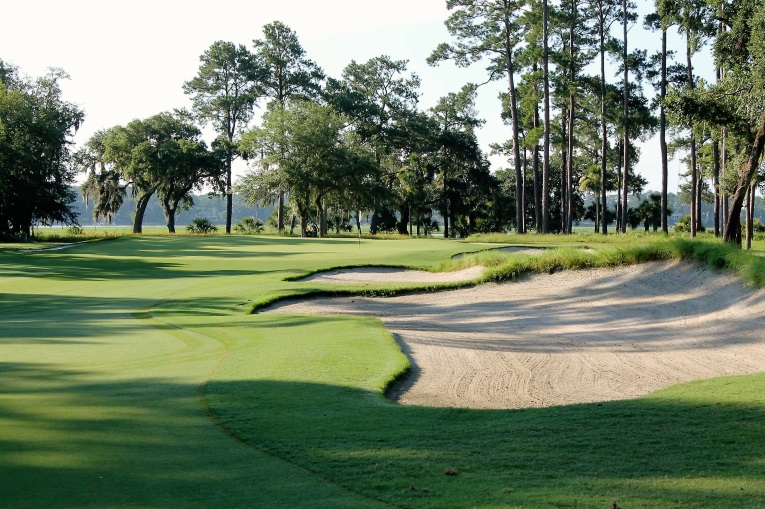
The golfer is teased by partial views of Chechessee Creek behind the 6th green. One thing is for sure – the day’s wind is often not fully accounted for on the approach.
Seventh hole, 180 yards; With Chechessee Creek and the tidal marsh on the left, the serene setting belies the fact that this is a tough par. A roughed up mound sixty yards shy of the green creates depth perception problems which are compounded by a severe false front: the darn thing occupies almost the front third of the green, thus transforming the green into one of the smaller targets on the course. Settling for a chip and putt par short of the green isn’t the worst outcome with so much trouble lurking left and right.

The fronting bunkers that dominate the view are actually well shy of the putting surface. The shadow across the front of the green happens to almost perfectly delineate the false front.

The afternoon shadows hold their own allure, as does watching the boating activity along Chechessee Creek.
Eighth hole, 440 yards; Though scenic, the four holes that conclude the front nine comprise the course’s toughest stretch and this hole is the most heavily bunkered two shotter on the course. Unless a good tee ball is away, a pair of cross bunkers that angle across the fairway fifty yards shy of the green become problematic. Even though six, eight and nine are all burly two shotters, they bear little resemblance to one another. Creating such variety over flat land is no small feat. Better yet, they each play markedly different from one another, in part due to how they head in different directions (key when the coastal winds kick up).
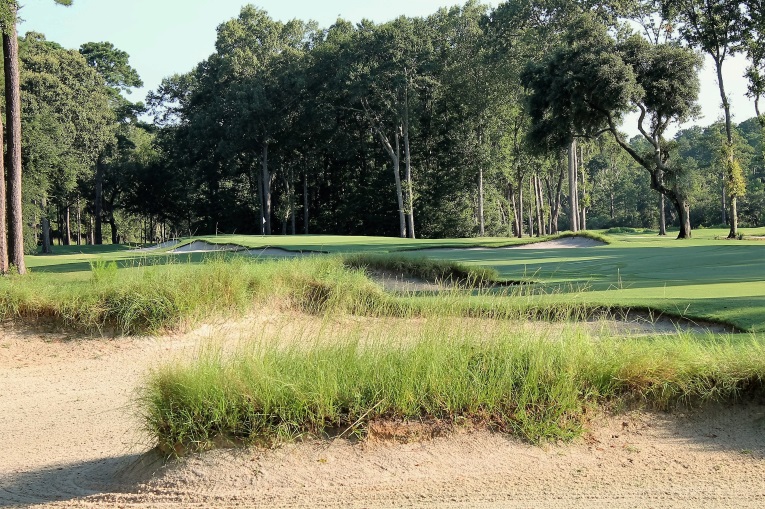
The tee ball at the 8th needs to avoid these two bunkers left of the fairway as well as the one right.

This appealing bunkering scheme cuts 50 yards in front of the green and tracks down the green’s left side.
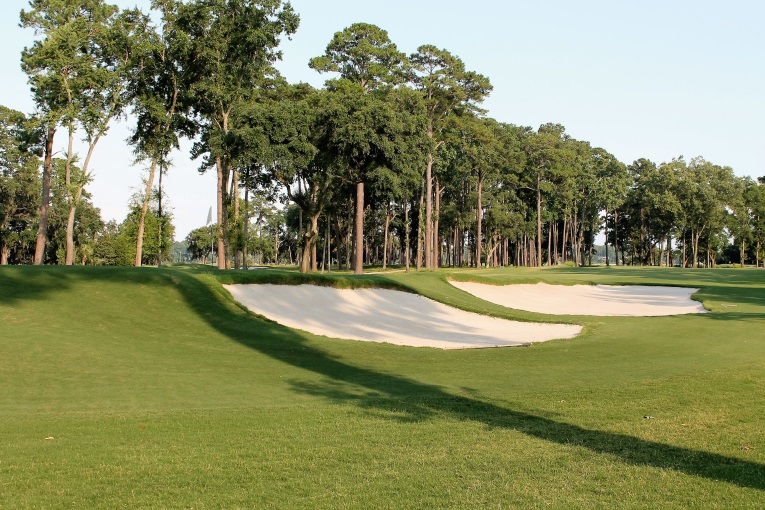
As seen from near the 9th tee, this view back of the 8th green highlights how Coore & Crenshaw created depth to the bunkers by building up the green pads just enough to make them attractive targets. Also, the short fifty yard walk from green to tee is repeated throughout the course, making the flat Chechessee a dream walking course.
Ninth hole, 465 yards; A welcome return to 40+ yard wide fairways and multiple playing angles was already under way at the high end of course design when Chechessee Creek opened in 2000. Now, 16 years on, the pendulum may have swung too far. Senselessly wide fairways to dullish greens make for a bomber’s delight while disadvantaging all but the most powerful. The beauty of Chechessee Creek is its proportionality; everything is sized right for the task at hand which frequently varies. A wisp of a two shotter like the first features the course’s smallest green while the brutishly long one shot sixteenth features the largest green at two and half times the size. So it is here, at the ninth, which is the longest two shotter on the course. Not surprisingly, the fairway is the widest on the course, 56 paces across and the putting surface is the second biggest target on the course at nearly 8,700 square feet. After the tee ball passes a distinctive bent pine tree off the tee, the beauty of the hole reveals itself.

To appreciate how far golf architecture has come since the 1960s when greens were dullishly bunkered left and right, look at the imaginative – and random – bunkering at the ninth. Despite its length, the hole beguiles. The TifGrand in front of the open green is less ‘grabby’ than the 419 it replaced and helps the hole play as Coore & Crenshaw intended.
Eleventh hole, 210 yards; When the golfer first glances at the scorecard and sees a 6,640 yard course, he may think that the need for long iron shots will be infrequent – and he would be wrong. As six of the two shooters are longer than 400 yards and three of the one shotters longer than 190 yards, the golfer’s long iron game gets a work out, even in still conditions. Newell has concluded that ‘… the strength of the course lies in the five Par 3s. We have a great assortment ranging from 164 to 244 yards. In 2003, Chechessee Creek hosted the Carolinas Amateur featuring many of the best players in North and South Carolina. In relation to par, three of the four hardest holes were par 3s, including the eleventh. If you play the threes well, you will have a good round.’ The tension on this hole is created by the dominant front left bunker and the tilt of the green toward it.
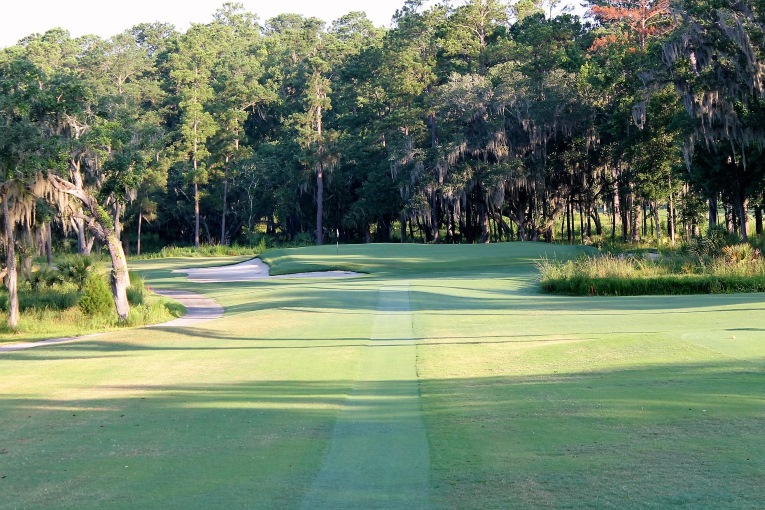
Though wetlands are near the 11th green, the golfer is still given room to play – and time to admire the live oaks dripping with moss. What may escape notice from the tee is how severely the green is pitched from back to front and right to left. The green is the scene of many a 3 putt. The rattled golfer grumps his way to the nearby 12th tee, where he then generally makes a meal of it too!
Twelfth hole, 340 yards; Courses built 90 years ago rarely featured numerous forced carries and this is the sole one of any meaningful distance (the one on the fifteenth is less than 60 yards). Without a doubt, the wedge approach is the trickier of the two shots for the better player. This green is the only one that is wider than it is deep and features a bunker that eats into its middle, creating a bit of a boomerang. When the hole is located directly behind the bunker, the golfer is wise to use the green’s contours as a back stop. Disher appreciates how the green ‘… creates some very strange situations. I have seen an approach from the right of the fairway to a hole cut on the left wing played by directing the shot to the right wing and having the ball release in a semi-circle around the bunker. I love fun greens like this.’
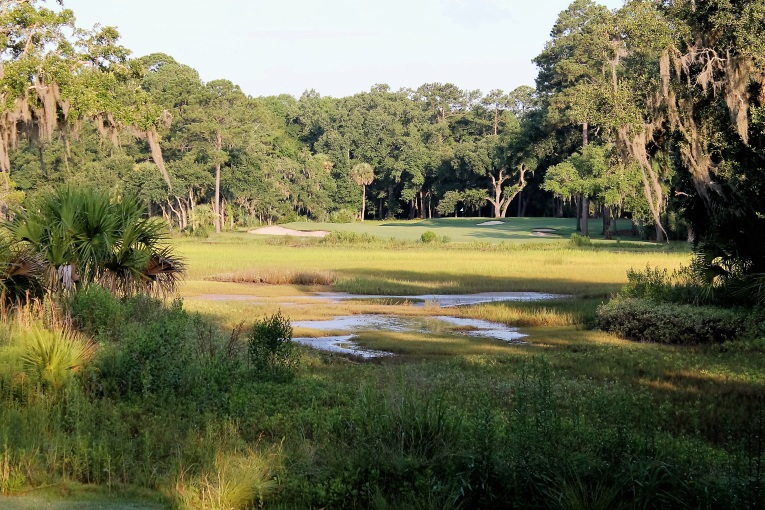
Conjure up all the components that excite people about the Lowcountry and you’ll find that they are present in this photograph from the twelfth tee.

Coore & Crenshaw are loath to repeat themselves. If there is one single feature that is most oft found throughout their work, it might be a tiny bunker clawing into the front middle of a putting surface. Examples include Friar’s Head, Colorado GC, We-Ko-Pa, Sand Hills, and here. Numerous interesting hole locations always ensue.
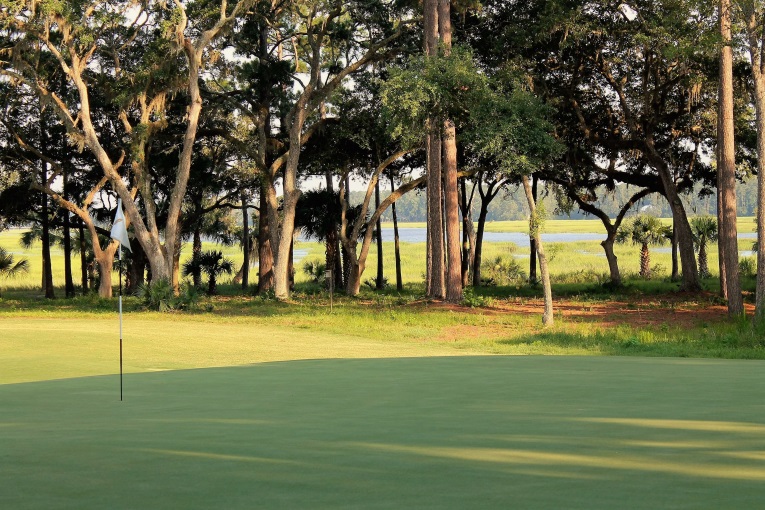
As seen in the filtered light, the 2015 tree study lead the club to remove underbrush and limb-up healthy trees, to increase light, air circulation – and vistas.
Thirteenth hole, 165 yards; Though one should rarely if ever lose a ball here, playing to one’s handicap remains quite the task. In many ways, the thirteenth epitomizes the challenge: Within reach of all skill sets, the target (i.e. the green) is elusive to find and if missed, three additional shots are more likely than two. As seen below in the early morning light, the green is wide in the front and narrows as it swings right and falls away. Jeff Bradley, who normally sticks to bunkers, deserves much of the credit for this vexing green complex.
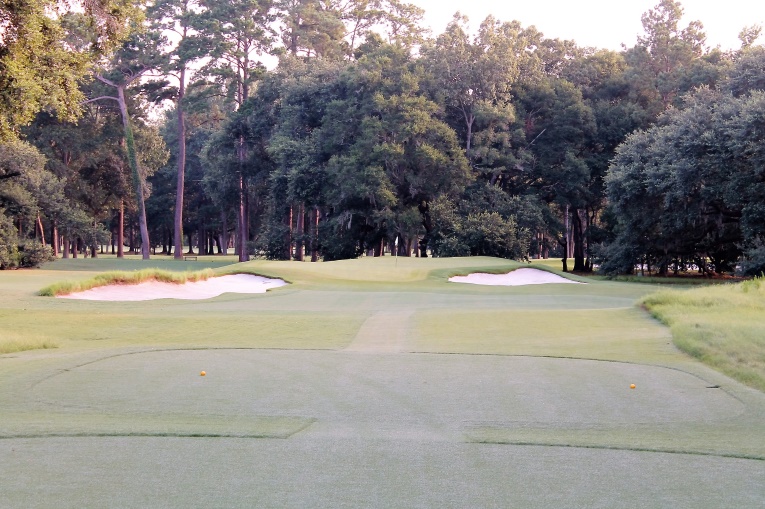
The bunkering makes the 13th deceptively difficult: the 30 yard long left front bunker barely touches the green’s front edge while the right bunker is deep into the kidney shaped green.
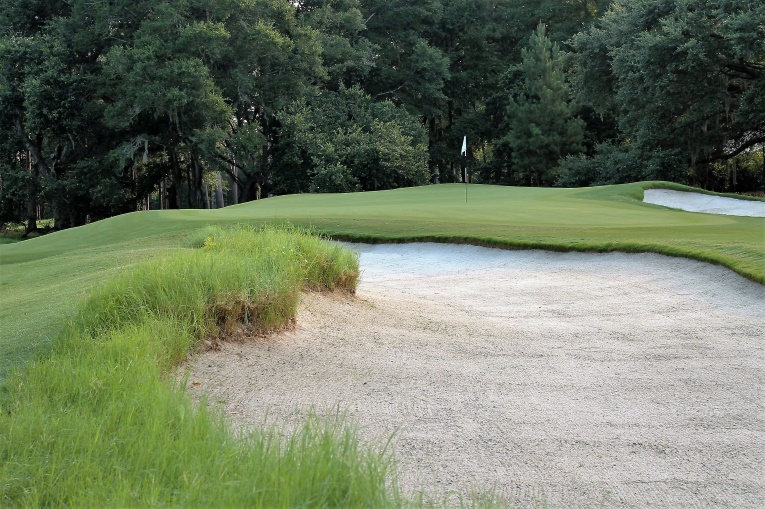
This view from short left indicates how the green is wide in front before narrowing toward the rear. Chasing after back hole locations is fool’s gold.

In an effort to avoid the right bunker, many a member tugs his tee ball left, resulting in a tricky recovery from a tightly mown area. Decisions, decisions!
Fourteenth hole, 405 yards; Risk-reward decisions abound off the tee. The golfer who hits it around 230 yards generally finds the wider portion of the fairway while the golfer intent on hitting it 275 yards is often required to shape the ball into a narrower neck. Both skill sets have equal fun playing the course.

Should the golfer shorten the approach by hugging the right off the 14th tee? Kennedy smiles when he notes that the branch in the top right of the photograph is the most hit (and cursed!) limb on the property.
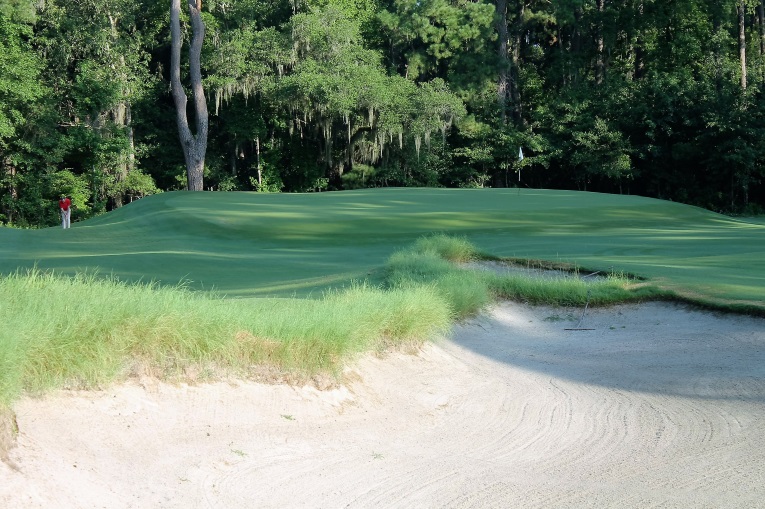
The gentleman in red has a realistic chance of orchestrating an up and down because he didn’t short-side himself. Far more problematic …
Fifteenth hole, 600 yards; The use of the wetland immediately off the tee is telling: rather than place a green on the far side, Coore & Crenshaw placed the tee on the near side, making the short carry from a perfect lie of the tee a non-event. Countless modern courses in South Carolina have greens bordered by wetlands, from which there is no recovery. The concept of finishing a round at Chechessee with the same ball that one started is part of the fun and greatly differentiates it from most coastal courses. Also worth noting is how the identification of two specimen trees led to the hole’s ultimate creation – and length. 150 yards shy of the green on the right is a low-lying live oak with a base greater than 60 inches. Another mighty one is by the green. If the golfer takes on the first live oak and the enormous bunker just past it, he is rewarded with a clean look down the length of the green. If he doesn’t rub past the first live oak, the second farther ahead on the left increasingly inserts itself into the field of play.

Flirting with the live oak and bunker on the right leaves the best line to the green. As one shies away from the bunker, the live oak at the left front of the green becomes a concern.
Sixteenth hole, 245 yards; Of all the famous holes in the world, the author’s least favorite is the sixteenth at Carnoustie Golf Links. At 245 yards, he likes the half par distance but Carnoustie’s is a bore because it is bunkered tightly left and right. Only one type shot will do and little thought is required. Conversely, the sixteenth at Chechessee is the same appealingly awkward length but the golfer is free to play it any number of ways. Notable features of the green complex include the interaction between the bunker thirty yards short right of the green and the pair of five foot deep left greenside bunkers, how the green’s open front allows for a running shot, and the large tightly mown area right. At well over 10,000 square feet, the green fits the ask from the tee, though it certainly elicits plenty of three putt bogeys.
Seventeenth hole, 335 yards; Pete Dye preaches about angles. Bill Coore, who once worked for Dye, perfects the notion of multiple playing angles here at the seventeenth. This two shotter encourages bold play off the tee, goading the player toward the direct route, which requires a 255 yard carry over wetland and a pair of bunkers. Alternatively, the golfer can aim left and take less risk, albeit leaving himself a longer approach from a disadvantaged angle. A wonderful penultimate hole, the course’s shortest two shotter represents a fine change of pace among the long fifteenth, sixteenth, and eighteenth holes.

Do you lay-up short of this wetland, beside it or risk carrying it? Surely the answer depends both on the state of your match as well as the state of your game at that moment.
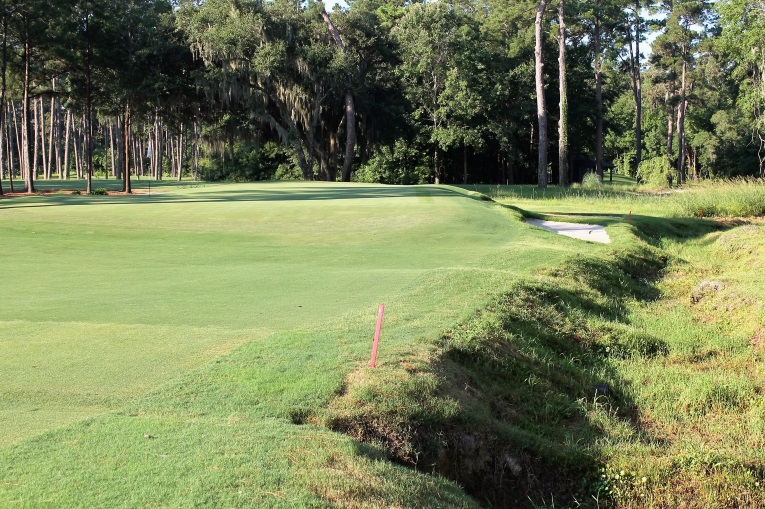
The long green progressively narrows toward the back and its axis favors the player that flirts with the hazard.
It is worth reiterating that trees play a more fundamental role in defining the character of the golf here than at any other Coore & Crenshaw course profiled on this website: the lone pine in the fifth fairway, the crooked pine 200 yards off the ninth tee, the trees tight down the right of the twelfth, the pine protruding into the fourteenth fairway, the live oaks on the fifteenth, the lone pine on the seventeenth, and a nest of trees on the inside of the dogleg eighteenth are but a few examples. They had no such options at Sand Hills but the use of select trees is a good example of Coore & Crenshaw adapting their style to take advantage of a site’s natural attributes.
The ability of trees to enchant is also what lead the clubhouse to be placed where it is opposed to along the marsh behind the tenth green. Sue Coore (Bill’s wife) was convinced of the merits of today’s location, which was a relief to Bill as logistical issues loomed if the clubhouse was hemmed-in along the marsh. With the clubhouse inland, a seamless integration soon occurred for the parking, lodging, clubhouse, practice field, and returning nines. The flow is wonderful.
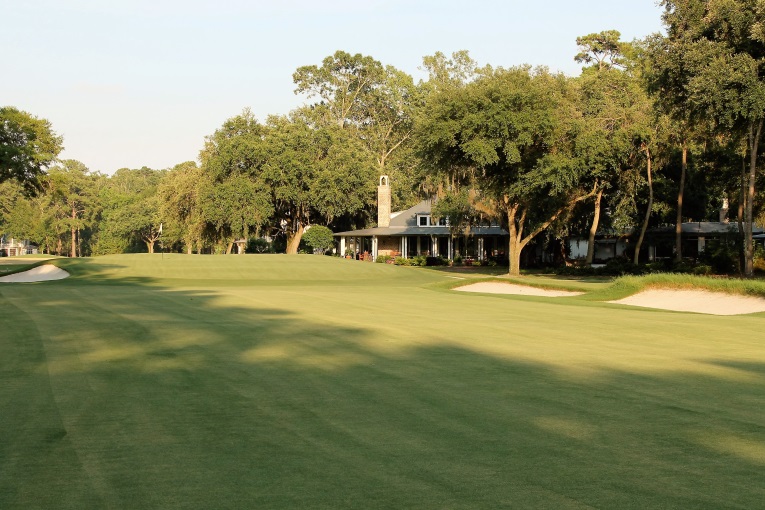
This view down the Home hole captures how the clubhouse is snuggled into the environment rather than imposed upon it.
In many respects, the clubhouse sets the tone for the entire experience. Discretion carries the day. This is most assuredly not a golf factory; those interested in pomp and circumstance should look elsewhere. At Chechessee Creek, the game is put on the pedestal and traditionalists appreciate just how alluring it can be. True, there are no five at Royal Portrush or eleven at Ballybunion moments here; the topography doesn’t lend itself for such. Yet, the combination of all the components and the immaculate attention to detail that the new ownership has brought yields a deeply satisfying experience.
Coore & Crenshaw delivered what golfers want – a thinking experience for all level players. Refinements now in place enable what The Old Course has long illustrated: the best contours for golf are often only two to five feet. The course plays better and is better-suited to its membership than it has ever been. Word is out and golfers have noticed. Memberships have surged to the point where the club is approaching nearly 400 members, the most it has ever had. Proctor’s desire for the club to enjoy a low key vibrancy during the primary playing season of October through April has come true. It’s nice in this day and age of ‘loud’ that something restrained is still appreciated – and there to be savored.
The End


